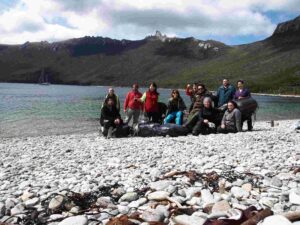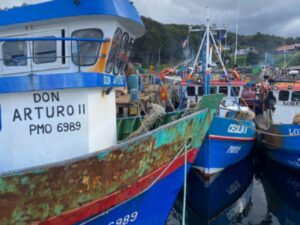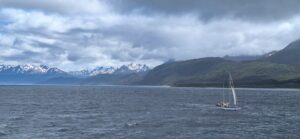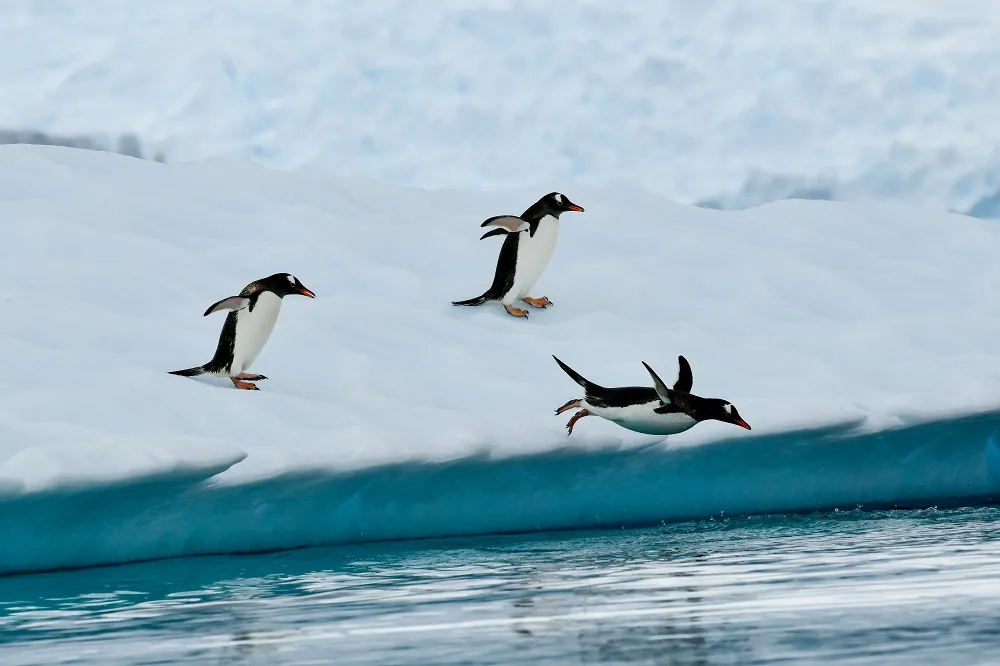Ocean Tramp Day 6
As the days never seem to truly end, this day begins with the evening before. Just as we were winding down from an exciting and satisfying first full day in Antarctica and a belly full of lasagna (thanks Mak!), some of us already tucked in bed, Voj returned from a tender outing to tell us that he had spotted whales. A few of us quickly pulled on our gear and hopped into the zodiac with Voj and sped off to where he had last sighted them. Like magic, two majestic humpback whales were leisurely exploring a nearby cove, spouting and surfacing and showing us their tails. The sun angle was low – it was 21:00 – making the light was soft, rich, and warm. The two humpbacks took their time surfacing again and again, flipping their tails, breathing into the quiet stillness, leaving us hypnotized and some crying tears of joy. The night was quiet and calm and we slept deeply.
We awoke the next morning to brilliant blue skies and a gorgeous ice palette that spanned deep emerald green to bright blues of every hue. We learned that the ice color is due to the frozen organic matter (plants and animals) from the ocean deep frozen to the icebergs. The more organic matter, the deeper the color. However, sea marine ice is clear because it contains no gas bubbles. Around 0800, we hoisted the anchor in the Melchior Islands and headed to Isla Curverville via the Strait of Gerlache. Importantly, in the Strait of Gerlache there is a “geofence” – a zone marked by coordinates – where boats and ships cannot exceed 10 knots of speed in order to protect the many whales that are found there. How lovely that the whales come first. Thank you IAATO.
Icebergs are us! Our fearless captain Dave, assisted by the able crew (Eze, Voj, and Mak), carefully picked our way through the abundant sea ice. It was fascinating because in addition to large icebergs, there also was the endless art of ice formations including what looked like bobbing seabirds, whimsical modern art sculptures, and even a dinosaur or two. And everywhere we roamed, we saw penguins (they comprise 80% of the biomass of Antarctica according to one text we read on board). It seems that many of the Antarctic wildlife feed on the penguins causing us to dub them “the potato chips of the sea.”
We anchored in the cove at Isla Curverville quite near the Gentoo penguin rookery we were to visit. First, and most importantly before landing, we were educated on the biosecurity protocols and appropriate distancing and activity to protect the penguins. We were told to take nothing from the site (and all of Antarctica of course), including rocks, because the Gentoo spend a great deal of time selecting the perfect stones to build their nests. If the best stones are removed, we are interfering with their breeding. Later we saw the penguins choosing stones for their nests and carrying them up the snowy hill to make their nests. It is easy to see how important it is to leave no trace, to change nothing. We are incredibly privileged to be here and witness this.
We rapidly realized that the rookery was easy to spot as the penguin colony’s activities colors the snow. We are all now expert penguin colony spotters! We set off in the tenders to visit the rookery but first we passed a rather large leopard seal relaxing on an iceberg. We suspected that he might be keeping an eye on penguins he might like to eat for lunch… The leopard seal obligingly opened his mouth very wide for us several times and at least one of us became a tiny bit nervous. But all was well! We then landed on the rocky beach and watched the Gentoos trundling along the penguin highways – quite an extensive network of trails leading from penguin group to penguin group. Carefully avoiding these routes, we were able to hike up to the top of a hill and get an expansive view of the cove and many groups of penguins on the way up. This is a very busy time of year for these penguins as they are breeding, something we got to witness many times. There were so many penguins everywhere we looked. As nature would have it, penguins also attract Skua – seabirds that prey on penguin eggs and chicks. There were many Skua around landing in the colonies. One of us, Dana, captured an amazing photo of a Skua with a penguin egg in its beak. Other Gentoo were sliding along on their bellies – not only downhill but along the penguin highways, propelling themselves by their fins. Sometimes they simply fell down. It was lovely and comical and mesmerizing. One result of the sliding was that some of the Gentoo had brown bellies, perhaps explaining why we later saw them bathing in the sea. Other Gentoos swam and “dolphined” which we learned was an efficient way for them to breathe while in the water.
It is now evening and the Ocean Tramp is softly swaying at anchor in our silent cove. The boat is surrounded by swimming Gentoo, the occasional school of small fish jumping out of the water to escape predators, glorious mountains of snow and ice, and what seems like a sentry of penguins standing guard over us atop the hill. It was a perfect day thanks to fine weather, sunny blue skies, and a kind and generous crew who made sure that we were immersed in the moment. How very lucky we are.
With gratitude,
Laura
Photo by Fred Meyerson

Why visit Isla de los Estados?
Why Visit Isla de los Estados? A hidden gem of untouched wilderness and breathtaking landscapes A hidden gem of the







